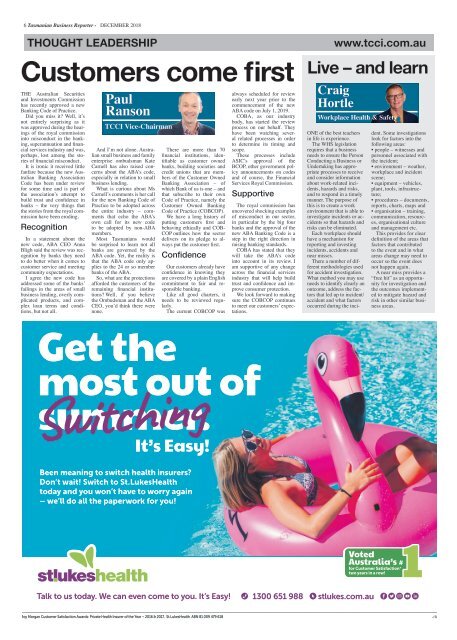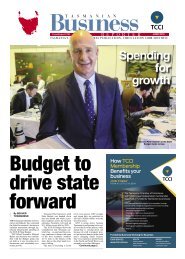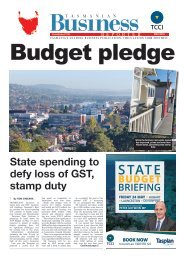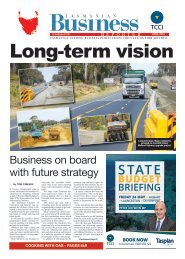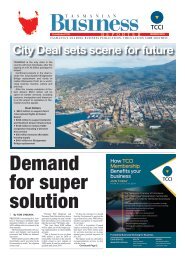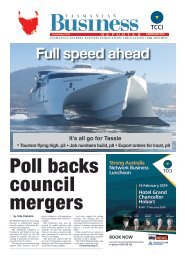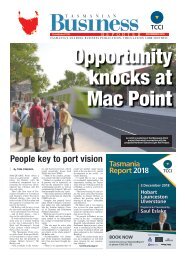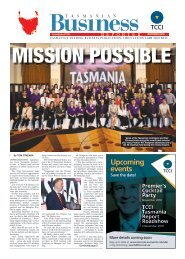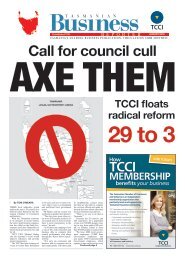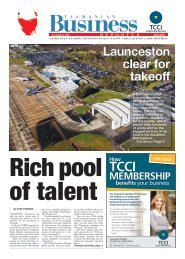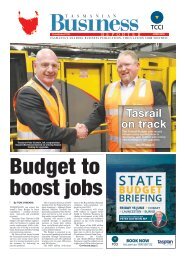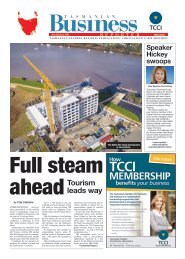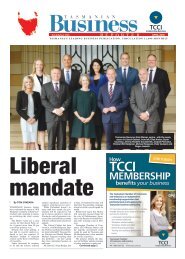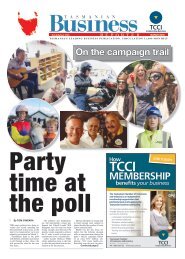Tasmanian Business Reporter December 2018
Welcome to the December edition of the Tasmanian Business Reporter. In the final edition for the year we bring you an exclusive preview of the 2018 Tasmania Report, with leading economist Saul Eslake calling for the State Government to give preferential treatment to new businesses in order to encourage job creation for better educated and higher paid employees. You will also find details about a $30 million residential redevelopment planned for a Hobart hotel, a $5.5 million research program for the forestry sector and a boost for retailers with the Government considering enhancing the authority of retail staff to inspect customer's bags as they exit a store.
Welcome to the December edition of the Tasmanian Business Reporter.
In the final edition for the year we bring you an exclusive preview of the 2018 Tasmania Report, with leading economist Saul Eslake calling for the State Government to give preferential treatment to new businesses in order to encourage job creation for better educated and higher paid employees.
You will also find details about a $30 million residential redevelopment planned for a Hobart hotel, a $5.5 million research program for the forestry sector and a boost for retailers with the Government considering enhancing the authority of retail staff to inspect customer's bags as they exit a store.
You also want an ePaper? Increase the reach of your titles
YUMPU automatically turns print PDFs into web optimized ePapers that Google loves.
6 <strong>Tasmanian</strong> <strong>Business</strong> <strong>Reporter</strong> - DECEMBER <strong>2018</strong><br />
THOUGHT LEADERSHIP<br />
Customers come first<br />
THE Australian Securities<br />
and Investments Commission<br />
has recently approved a new<br />
Banking Code of Practice.<br />
Did you miss it? Well, it’s<br />
not entirely surprising as it<br />
was approved during the hearings<br />
of the royal commission<br />
into misconduct in the banking,<br />
superannuation and financial<br />
services industry and was,<br />
perhaps, lost among the stories<br />
of financial misconduct.<br />
It is ironic it received little<br />
fanfare because the new Australian<br />
Banking Association<br />
Code has been under review<br />
for some time and is part of<br />
the association’s attempt to<br />
build trust and confidence in<br />
banks – the very things that<br />
the stories from the royal commission<br />
have been eroding.<br />
Recognition<br />
In a statement about the<br />
new code, ABA CEO Anna<br />
Bligh said the review was recognition<br />
by banks they need<br />
to do better when it comes to<br />
customer service and meeting<br />
community expectations.<br />
I agree the new code has<br />
addressed some of the banks’<br />
failings in the areas of small<br />
business lending, overly complicated<br />
products, and complex<br />
loan terms and conditions,<br />
but not all.<br />
Paul<br />
Ranson<br />
TCCI Vice-Chairman<br />
And I’m not alone. Australian<br />
small business and family<br />
enterprise ombudsman Kate<br />
Carnell has also raised concerns<br />
about the ABA’s code,<br />
especially in relation to small<br />
business lending.<br />
What is curious about Ms<br />
Carnell’s comments is her call<br />
for the new Banking Code of<br />
Practice to be adopted across<br />
the entire industry – comments<br />
that echo the ABA’s<br />
own call for its new code<br />
to be adopted by non-ABA<br />
members.<br />
Most <strong>Tasmanian</strong>s would<br />
be surprised to learn not all<br />
banks are governed by the<br />
ABA code. Yet, the reality is<br />
that the ABA code only applies<br />
to the 24 or so member<br />
banks of the ABA.<br />
So, what are the protections<br />
afforded the customers of the<br />
remaining financial institutions?Well,<br />
if you believe<br />
the Ombudsman and the ABA<br />
CEO, you’d think there were<br />
none.<br />
There are more than 70<br />
financial institutions, identifiable<br />
as customer owned<br />
banks, building societies and<br />
credit unions that are members<br />
of the Customer Owned<br />
Banking Association – of<br />
which Bank of us is one – and<br />
that subscribe to their own<br />
Code of Practice, namely the<br />
Customer Owned Banking<br />
Code of Practice (COBCOP).<br />
We have a long history of<br />
putting customers first and<br />
behaving ethically and COB-<br />
COPoutlines how the sector<br />
delivers on its pledge to always<br />
put the customer first.<br />
Confidence<br />
Our customers already have<br />
confidence in knowing they<br />
are covered by a plain English<br />
commitment to fair and responsible<br />
banking.<br />
Like all good charters, it<br />
needs to be reviewed regularly.<br />
The current COBCOP was<br />
always scheduled for review<br />
early next year prior to the<br />
commencement of the new<br />
ABA code on July 1, 2019.<br />
COBA, as our industry<br />
body, has started the review<br />
process on our behalf. They<br />
have been watching several<br />
related processes in order<br />
to determine its timing and<br />
scope.<br />
These processes include<br />
ASIC’s approval of the<br />
BCOP, other government policy<br />
announcements on codes<br />
and of course, the Financial<br />
Services Royal Commission.<br />
Supportive<br />
The royal commission has<br />
uncovered shocking examples<br />
of misconduct in our sector,<br />
in particular by the big four<br />
banks and the approval of the<br />
new ABA Banking Code is a<br />
step in the right direction in<br />
raising banking standards.<br />
COBA has stated that they<br />
will take the ABA’s code<br />
into account in its review.I<br />
am supportive of any change<br />
across the financial services<br />
industry that will help build<br />
trust and confidence and improve<br />
consumer protection.<br />
We look forward to making<br />
sure the COBCOP continues<br />
to meet our customers’ expectations.<br />
www.tcci.com.au<br />
Live – and learn<br />
Craig<br />
Hortle<br />
Workplace Health & Safety<br />
ONE of the best teachers<br />
in life is experience.<br />
The WHS legislation<br />
requires that a business<br />
needs to ensure the Person<br />
Conducting a <strong>Business</strong> or<br />
Undertaking has appropriate<br />
processes to receive<br />
and consider information<br />
about work-related incidents,<br />
hazards and risks,<br />
and to respond in a timely<br />
manner. The purpose of<br />
this is to create a work<br />
environment that is able to<br />
investigate incidents or accidents<br />
so that hazards and<br />
risks can be eliminated.<br />
Each workplace should<br />
have a mechanism for<br />
reporting and investing<br />
incidents, accidents and<br />
near misses.<br />
There a number of different<br />
methodologies used<br />
for accident investigation.<br />
What method you may use<br />
needs to identify clearly an<br />
outcome, address the factors<br />
that led up to incident/<br />
accident and what factors<br />
occurred during the incident.<br />
Some investigations<br />
look for factors into the<br />
following areas:<br />
• people – witnesses and<br />
personnel associated with<br />
the incident;<br />
• environment – weather,<br />
workplace and incident<br />
scene;<br />
• equipment – vehicles,<br />
plant, tools, infrastructure;<br />
• procedures – documents,<br />
reports, charts, maps and<br />
• organisation – training,<br />
communication, resources,<br />
organisational culture<br />
and management etc.<br />
This provides for clear<br />
definition of the areas that<br />
factors that contributed<br />
to the event and in what<br />
areas change may need to<br />
occur so the event does<br />
not happen again.<br />
A near miss provides a<br />
“free hit” as an opportunity<br />
for investigation and<br />
the outcomes implemented<br />
to mitigate hazard and<br />
risk in other similar business<br />
areas.<br />
for Customer Satisfaction*<br />
two years in a row!


